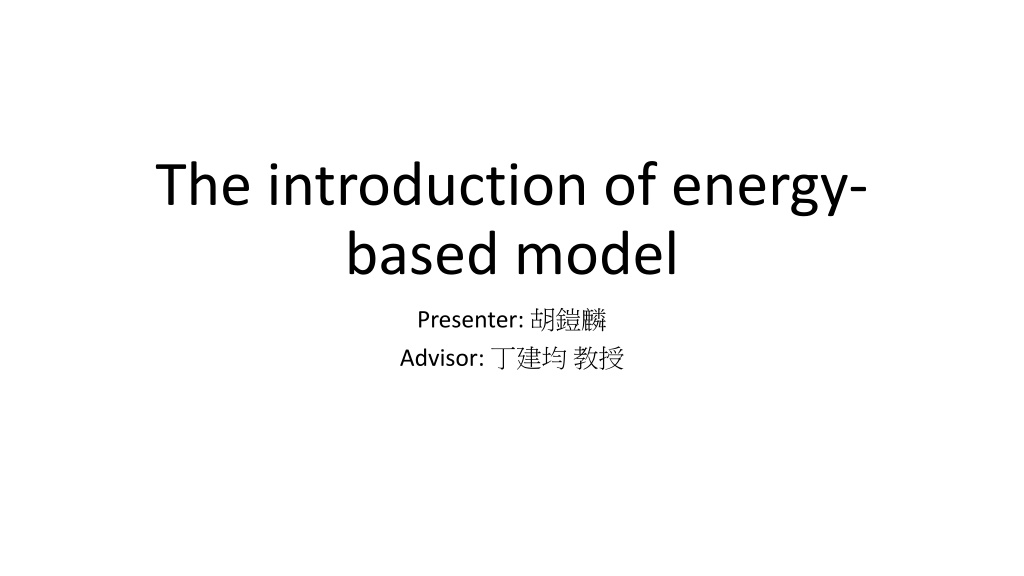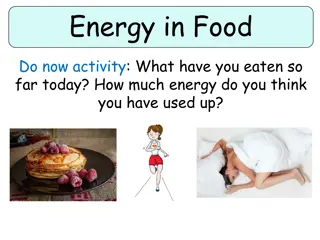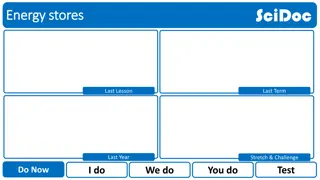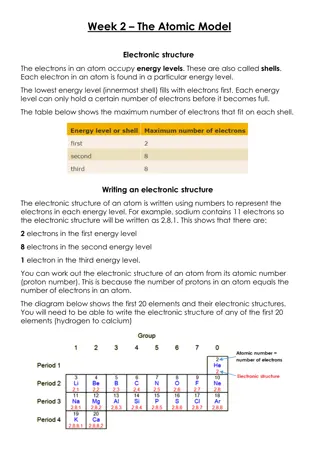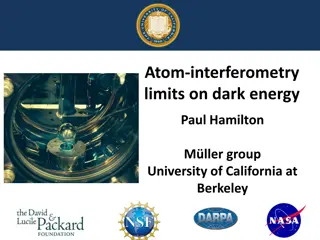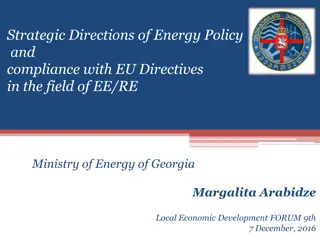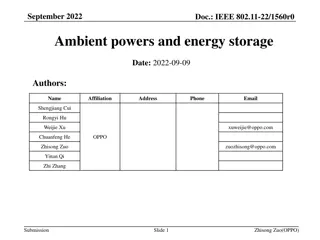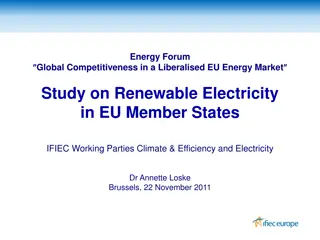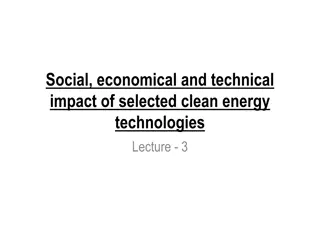The introduction of energy- based model
"Introducing an energy-based model presenter advisor to streamline and enhance decision-making processes. This innovative approach combines expertise and insights to empower users in optimizing energy-related tasks more efficiently. Discover the benefits of implementing this advisor in your operations and stay ahead in the dynamic energy sector."
Download Presentation

Please find below an Image/Link to download the presentation.
The content on the website is provided AS IS for your information and personal use only. It may not be sold, licensed, or shared on other websites without obtaining consent from the author.If you encounter any issues during the download, it is possible that the publisher has removed the file from their server.
You are allowed to download the files provided on this website for personal or commercial use, subject to the condition that they are used lawfully. All files are the property of their respective owners.
The content on the website is provided AS IS for your information and personal use only. It may not be sold, licensed, or shared on other websites without obtaining consent from the author.
E N D
Presentation Transcript
The introduction of energy- based model Presenter: Advisor:
Agenda Definition of energy model Loss functions in energy model Negative log-likelihood loss(NLL loss) Sampling method
Energy-Based Model for Decision Making Model: Measures the compatibility between an observed variable X and a variable to be predicted Y through an energy function ? ?,? ? = argmin ? ?,? ? ? Inference: Search for the ? that minimizes the energy within a set ?
Complex Tasks: Inference is nontrivial When the cardinality or dimension of ? is large, exhaustive search is impractical. If the set ? has low cardinality, we can use exhaustive search. Face recognition Image restoration ? is a high-cardinality discrete variable ? is a high-dimensional continuous variable (an image).
Designing a Loss Function Push down on the energy of the correct answer Pull up on the energies of the incorrect answers, particularly if they are smaller than the correct one Yi: correct answer
Energy loss The energy loss is defined as ??????? ??,? ??,? = ? ??,?? This loss usually applied in regression or neural network training. Ex: 2 ? ??,??= ?? ? ?? this loss will push down on the energy of the desired answer, it will not pull up on any other energy With some architectures, this can lead to a collapsed solution in which the energy is constant and equal to zero
Generalized Perceptron Loss The generalized perceptron loss for a training sample ??,??is defined as ??????????? ??,? ??,? = ? ??,?? min ? ?? ??,? Minimizing this loss has the effect of pushing down on ? ??,??, while pulling up on the energy of the answer produced by the model Major deficiency: there is no mechanism for creating an energy gap between the correct answer and the incorrect ones. Hence, as with the energy loss, the perceptron loss may produce flat (or almost flat) energy surface.
Generalized margin loss Such kind of loss usually use some form of margin to create an energy gap between the correct answer and the incorrect answers. Several loss functions can be described as margin losses; the hinge loss, log loss, LVQ2 loss, minimum classification error loss, square-square loss, and square- exponential loss
Examples of Loss Functions: Generalized Margin Losses First, we need to define the Most Offending Incorrect Answer Most Offending Incorrect Answer Let Y be a discrete variable. Then for a training sample ??,??, the most offending incorrect answer ??is the answer that has the lowest energy among all answers that are incorrect: Discrete case Continuous case ??= argmin ??= ? ?,? ??? ??,? ? ??,? argmin ? ?, ? ??>?
Examples of Loss Functions: Generalized Margin Losses The generalized margin loss is the more robust version of generalized perception loss, as it directly use the energy of the most offending incorrect answer in the contrastive term ?????????,??= ?? ? ??,??,? ??, ?? Here ? is a positive parameter called margin and ??is a function whose gradient has a positive dot product with vector 1, 1 ? ??, ?? is bigger than ? ??,?? by at least ?
Hinge Loss and Log loss Hinge loss ? ??????,??= ??? 0,? + ? ??,?? ? ??, ?? margin: ? Log loss margin: ??????,??= log 1 + ?? ??,?? ? ??, ?? Hinge loss Log loss
Square-square loss 2 ??? ????,??= ? ??,??2+ max 0,? ? ??, ?? Learning ? = ?2
OTHER LOSS LVQ2 loss ????2??,??= ??? 1,??? 0,? ??,?? ? ??, ?? margin: 0 ?? ??, ?? The loss is saturated when the ratio between ? ??,??and ? ??, ?? Square-Exponential loss ??? ?????,??= ? ??,??+ ?? ? ??, ?? margin: +
Negative log likelihood loss Considering the conditional probability of ??given ??that is produced by model with parameter ? ? ? ??, ?1|??, ?1;? = ? ??|??;? ?=1 Maximize the above equation is equivalent to minimize the following equation ? ? ? ??|??;? = log? ??|??;? log ?=1 ?=1
Negative log likelihood loss Suppose that the conditional probability follows Gibbs distribution, i.e. ? ?? ??,?;? ? ?? ?? ??,?;? ? ?|??;? = The negative log conditional probability equation becomes ? ?? ??,?;? + log ? ?? ?? ??,?;? ?=1 The NLL loss is the normalized form of above equation ????? =1 ? ?? ??,?;? +1 ?log ? ?? ?? ??,?;? ? ? ?=1 ? = ??,?? ?=1
Negative log likelihood loss While many of the previous loss functions involved only ? ??, ??in their contrastive term, the negative log-likelihood loss combines all the energies for all values of Y in its contrastive term 1 ?log ? ?? ?? ??,?;? This contrastive term causes the energies of all the answers to be pulled up. The energy of the correct answer is also pulled up, but not as hard as it is pushed down by the first term.
Negative log likelihood loss Unfortunately, there are many interesting models for which computing the integral over ? is intractable. Many approximation methods, including Monte-Carlo sampling methods, and variational methods have been devised as approximate ways of minimizing the NLL loss, they can be viewed in the energy-based framework as different strategies for choosing the ? whose energies will be pulled up
???????,?? ?? =?? ??,?? ?? ??,?? ?? Gradient of NLL loss ? ?|??;? ?? ? ? Here, a resampling methods called Metropolis-Hastings is introduced to alleviate the computation burden for the integral operation in contrastive term due to the high cardinality of ? Metropolis-Hastings is one of many methods in MCMC(Markov Chain Monte- Carlo). The MCMC allows us to draw samples from posterior distribution rather than a distribution we can t sample from directly, and only requires few samples, a function ? and some priors about the parameters.
? ?|? =? ?|? ? ? By Bayes formula, we have ? ? First, we need a proposal distribution ? ? |? to help draw samples from the intractable posterior distribution ? ?|? . The Q function is usually be a symmetric function. The likelihood of new data is computed by a function called ?, which has a limitation about it ? ? ?|? ?( ?) Define the accepted rate as the ratio ? ? |? ? ?|? ?? ??|? ? ? ?? ??|? ? ? ? =? ? |? ? ?|? =? ?|? ? ? ? ?|? ? ? = ?=1 ?=1 P ?????? = 1, ? 1 ?,?? ??????
Examples: We sample 30000 points from a normal distribution with mean 10 and std 3 Then we drawn 1000 of them to be the observed data The objective now is to estimate the std from the observations
The proposal distribution is set to be ? ? = ????????,1 ?? ?2 2?2 1 2??? The likelihood function is set to be ? ?,? = ? ? = 1,??? ? 0 0,?? ?????? The prior is The algorithm runs
After 50000 iterations, the number of accepted params are about 8500 Since the results from early stage is still unstable, we drop the initial 25% accepted samples Take the average of the rest 75% samples, the estimated std is about 3.05, which is very close to the std we expected (3)
? ????? =1 ?? ??,?;? +1 ?log ? ?? ?? ??,?;? ? ?=1 N ? ????? =1 ?? ??,?;? +1 ? ?? ??,?;? ? ?=1 ?log ?=1 ?1, ??~P?
Reference Song, Y., & Kingma, D. P. (2021). How to train your energy-based models. arXiv preprint arXiv:2101.03288. LeCun, Y., Chopra, S., Hadsell, R., Ranzato, M., & Huang, F. (2006). A tutorial on energy- based learning. Predicting structured data, 1(0). IJCAI 2022 Tutorial on Deep Energy-Based Learning https://github.com/Joseph94m/MCMC https://jeremykun.com/2015/04/06/markov-chain-monte-carlo-without-all-the-bullshit/
